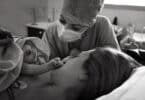
But finding a solution may be essential for the well-being of mothers and their children. The increased cesarean rates are an even bigger problem since more women are delivering today than they were a decade ago. Even more worrisome is the fact that there are fewer and fewer maternity physicians for these expectant mothers to go to. The solution may rest in a study conducted on the South Community Birth Program in Vancouver, British Columbia.
The program was originally established to help deliver comprehensive care to pregnant, low-income women. Comprehensive care is provided by a collaboration of health care professionals: doulas, midwives, public health nurses and family doctors. The goal is to decrease the cesarean rates, hospital stay time of mother and baby, and level of medical intervention during delivery. If done effectively, it could reduce the stress on the current health care system.
To see if the program was working, the perinatal outcome of 1,238 women who attended this program was compared with the perinatal outcomes of 1,238 women of similar risk status who had received a standard level of care from midwives, obstetricians or family doctors. What they found may very well change how health care is viewed, not just in Canada, but across the world.
“Women who received collaborative, multidisciplinary, community-based care in the South Community Birth Program were less likely to have a cesarean delivery, had shorter hospital stays on average, and were more likely to breastfeed exclusively than women who received standard care,” said Dr. Patricia Jansen, School of Population and Public Health, University of British Columbia, and the Child and Family Research Institute, Vancouver, BC.
After comparing the results, researchers found that women in the birth program were 25% less likely to delivery by cesarean than those in the standard care group. This resulted in a shorter hospital stay for both mothers (51 hours vs. 73 hours) and their babies (48 hours vs. 71 hours). What’s more, birth program mothers had a 42% chance of having their babies delivered by a midwife; this was compared to only 7% in the standard care group. Researchers also found that other delivery interventions, like epidurals and induced labor, were less likely to occur in the women that attended the South Community Birth Program.
There are many reasons that this evidence can be valuable. Not only could it help reduce health risks to mothers and babies, it could help increase the number of midwife deliveries, which currently only account for about 10% of all births in the country. This could help to ensure that pregnant women continue to receive the level of care they deserve. It could also relieve some strain on the health care system since longer hospital stays and higher risks mean more care for both mothers and babies.
Unfortunately, the study was not able to account for why the reduced rate occurred – only that it did. For now, however, the study model may give others something to go by and expand on.
“Although our study design did not permit us to discern which components of the birth program were responsible for the observed differences, clinicians working in the program believe that their close working relationship, including their ability to discuss patient care facilitated by immediate and remote access to electronic medical records, fosters an environment in which they can continually support and learn from one another,” Janssen and her co-authors wrote. “These findings have important implications given the decreasing numbers f maternity care providers in Canada. [They] should encourage the implementation and evaluation of this interdisciplinary approach in other settings.”
Related Articles:
- Dad Catches Newborn after Mom Gives Birth in Family Car
- New Study to Explore Vitamin E Rich Soups for Asthma Prevention
- Fertility Awareness in Women Trying to Conceive Lacking, Researchers Say






